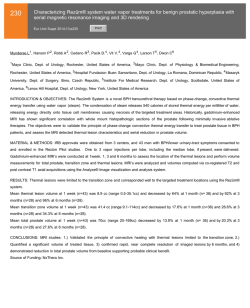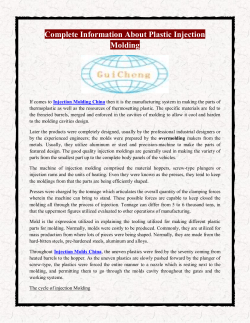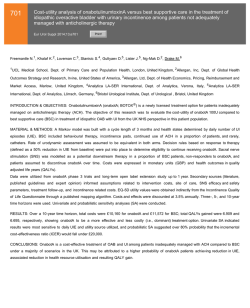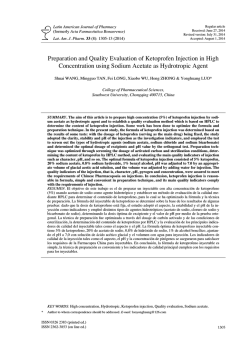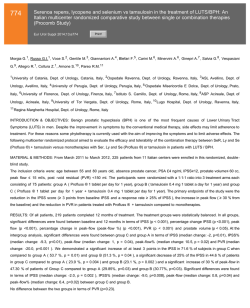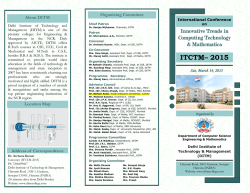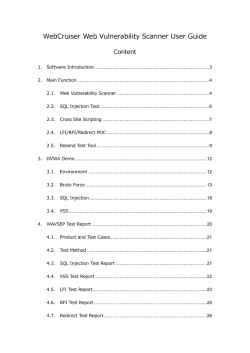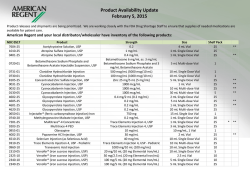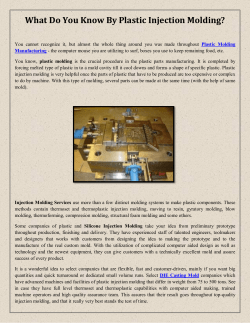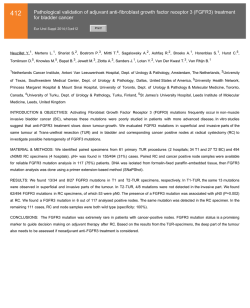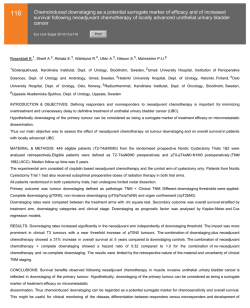
1-s2.0-S1569905614606849-main
694 Efficacy and safety of 2 administration modes of a single intra-detrusor injection of 750 units Dysport® (abobotulinum toxin-A) in patients suffering from neurogenic detrusor overactivity (NDO): A Phase IIa study Eur Urol Suppl 2014;13;e694 Print! Print! Denys P. 1 , Del Popolo G.2 , Amarenco G.3 , Karsenty G.4 , Radziszewski P. 5 , Perrouin-Verbe B. 6 , Grise P. 7 , Picaut P. 8 , Le Berre P. 8 , Padrazzi B. 8 , Beffy J-L. 9 , Dysport Y-52-52120-155 clinical trial 1 Hôpital Raymond Poincaré, Dept. of Service De Reeducation Neurologique, Garches, France, 2 Careggi University Hospital, Dept. of Neuro-Urology, Florence, Italy, 3 Hôpital Tenon, Dept. of Neuro-Urology, Paris, France, 4 Hôpital De La Conception, Dept. of Urology and Renal Transplant, Marseille, France, 5 NZOZ Centrum Medyczene Mazovia, Dept. of Urology, Warsaw, Poland, 6 Hôpital Hotel Dieu, Dept. of Urology, Nantes, France, 7 CHU de Rouen, Dept. of Urology, Rouen, France, 8 Ipsen Biopharm Limited, Dept. of Neurology, Les Ullis, France, 9 Ipsen Biopharm Limited, Dept. of Biostatistics, Les Ullis, France INTRODUCTION & OBJECTIVES: Symptoms related to NDO can be improved by intra-detrusor botulinum toxin-A (BoNT-A) injections in patients refractory to anticholinergics (AC); however, the optimal number of injection points has not been determined. This exploratory study aimed to assess efficacy and safety of 750 units (U) Dysport® administered at 15 or 30 injection sites, in patients with NDO secondary to Spinal Cord Injury (SCI) or Multiple Sclerosis (MS). MATERIAL & METHODS: This was a multicentre, double blind, randomized, single dose, placebo-controlled study. The primary end-point was the change from baseline (CFB) in daily incontinence episode frequency (DIEF) at Day 84 after treatment. Secondary endpoints included the assessment of other diary-reported symptoms, urodynamics (UD), Quality of Life (QoL), Physician’s Global Assessment (PGA), and drug safety. Patients with NDO with at least 2 daily incontinence episodes using a 3-day voiding diary, who were intolerant/refractory to AC, naïve to BoNT-A intradetrusor injection and using intermittent catheterization, were included. Patients were assigned to 1 of 4 groups (Dysport 750 U or placebo administered at 15 or 30 injection sites). Intra-detrusor injections were performed at predefined sites across the bladder sparing the trigone area, with a fixed volume of 0.5 ml per injection in all groups. RESULTS: Intent-to-treat analyses were performed on 42 adult patients (19 male/23 female, 22 SCI/20 MS) and adjusted to baseline values. At Day 84, mean CFB in DIEF decreased by 76% and 88% in the 15 and the 30 injection site groups, respectively. Other voiding diary parameters were in line with this improvement in DIEF and most of the patients treated with Dysport became fully continent (63%). Significant improvements in all UD parameters were observed as early as Day 14 in both Dysport groups: The mean maximum cystometric capacity increased by 150 mL and 207 mL in the Dysport 15 and 30 injection sites groups, respectively while the mean maximum detrusor pressure decreased by 26 cm H2 O and 24 cm H2 O. Patients’ QoL improved significantly in both Dysport groups (I-QoL and SF-Qualiveen), as well as the PGA. Mean rate of urinary tract infection (UTI) was 41% in Dysport versus 36% in placebo groups. Three muscle weakness episodes were reported in the Dysport 15 injection sites group (occurring in SCI patients at the same centre) with spontaneous favorable outcomes. No unexpected safety episode occurred in any of the groups. CONCLUSIONS: Both administration modes of 750 U Dysport assessed in this study were efficient in significantly improving incontinence, overall urinary symptoms, urodynamics and QoL in NDO patients. Clinical and UD outcomes seemed to be more favorable in the Dysport 30 injection sites group.
© Copyright 2025
